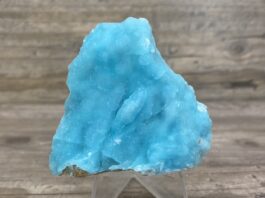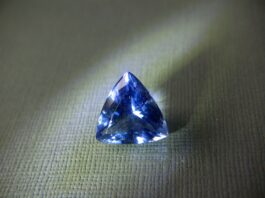Ceruleite is a beautiful and relatively rare mineral that belongs to the secondary copper mineral group. It is known for its stunning blue color and is often sought after by collectors and enthusiasts due to its vibrant appearance and unique crystalline structure. The name “ceruleite” is derived from the Latin word “caeruleus,” which means “sky-blue,” aptly describing the mineral’s distinct hue.

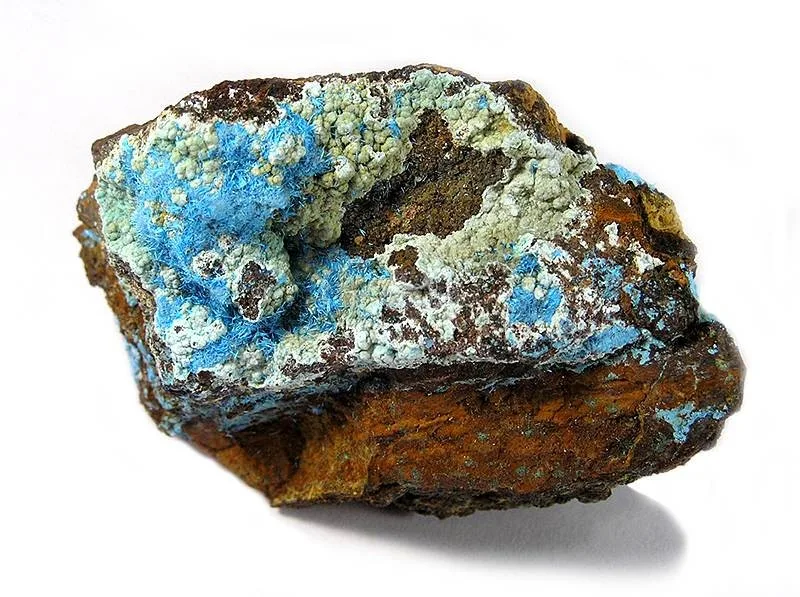
Key Points:
- Definition of ceruleite as a secondary copper mineral.
- Mention of its vivid blue color and its association with the Latin word “caeruleus.”
Physical and Chemical Properties of Ceruleite

Ceruleite possesses a range of physical and chemical properties that contribute to its distinctive appearance and its classification as a secondary copper mineral. Understanding these properties provides insights into the mineral’s characteristics and behavior.
Physical Properties:
- Color: Ceruleite is renowned for its captivating sky-blue color, which ranges from pale blue to deep azure. This unique coloration is a result of copper ions present within the crystal lattice.
- Luster: The mineral typically displays a vitreous to silky luster, giving it a somewhat reflective and appealing sheen.
- Crystal Habit: Ceruleite commonly forms tabular or prismatic crystals that can be quite small. These crystals often exhibit a bladed or platy habit, with individual plates arranged in layers.
- Transparency: Ceruleite crystals are usually transparent to translucent, allowing light to pass through and enhancing the perception of its color.
- Cleavage: The mineral has a basal cleavage, which means that it can break along planes parallel to the crystal’s base, resulting in flat, smooth surfaces.
- Hardness: Ceruleite has a relatively low hardness of about 2.5 to 3 on the Mohs scale. This means it can be easily scratched by harder minerals.
- Density: The density of ceruleite varies, but it generally falls within a range that is consistent with other copper-bearing minerals.
Chemical Properties:
- Chemical Composition: Ceruleite is a copper aluminum phosphate mineral with the chemical formula CuAl6(PO4)4(OH)8·4H2O. It contains copper (Cu), aluminum (Al), phosphorus (P), oxygen (O), and hydrogen (H) in its composition.
- Copper Content: The presence of copper in ceruleite is responsible for its distinctive blue color. Copper ions within the crystal structure absorb certain wavelengths of light, resulting in the blue coloration observed by the human eye.
- Hydration: Ceruleite is a hydrous mineral, meaning it contains water molecules within its crystal structure. The “4H2O” in its formula indicates the presence of four water molecules.
- Stability: Ceruleite is often found in oxidized zones of copper deposits, where it forms as a result of the alteration of primary copper minerals. It can form through interactions between copper minerals and oxygen-rich water, leading to the replacement of certain elements and the incorporation of others.
- Associations: Ceruleite is commonly found in association with other secondary copper minerals such as malachite (Cu2(CO3)(OH)2) and azurite (Cu3(CO3)2(OH)2).
Understanding these physical and chemical properties helps mineralogists and enthusiasts identify ceruleite and appreciate its unique qualities. Additionally, these properties play a role in how ceruleite interacts with light and its geological formation processes.
Occurrence and Geological Formations of Ceruleite

Ceruleite is typically found in specific geological settings where copper minerals undergo alteration and weathering processes. Its occurrence is closely linked to the oxidation of primary copper deposits and the interaction between copper-bearing minerals and various environmental factors.
Oxidized Zones of Copper Deposits: Ceruleite is commonly found in the oxidized zones of copper deposits. These zones are located near the Earth’s surface and are characterized by exposure to oxygen-rich air and water. As primary copper minerals in these deposits are subjected to weathering, they undergo chemical transformations, resulting in the formation of secondary copper minerals like ceruleite.
Alteration Processes: The formation of ceruleite is a result of alteration processes that involve the replacement of primary copper minerals by secondary minerals in the presence of water and oxygen. Primary copper minerals, such as chalcopyrite (CuFeS2), undergo chemical reactions that release copper ions into solution. These copper ions can then combine with other elements to form secondary copper minerals like ceruleite.
Weathering and Leaching: In oxidized zones, copper-bearing minerals are exposed to atmospheric conditions, including rainwater. Water percolates through the rock layers, leaching out soluble copper ions from primary minerals. These copper ions can subsequently precipitate and combine with other elements, including aluminum and phosphorus, to form secondary minerals like ceruleite.
Associated Minerals: Ceruleite often occurs alongside other secondary copper minerals, such as malachite and azurite. These minerals share similar formation conditions and are commonly found in the same geological settings. Malachite and azurite, with their green and blue colors respectively, complement the blue color of ceruleite, making them a visually appealing combination in mineral specimens.
Geological Environments: Ceruleite is more commonly found in arid or semi-arid regions where the oxidation of copper deposits is more pronounced due to exposure to dry and oxygen-rich air. Desert regions and areas with a history of mining activities are often associated with the discovery of ceruleite specimens.
Mineralogical Significance: Ceruleite’s occurrence and formation provide valuable insights into the geochemical processes that shape the Earth’s crust. The presence of ceruleite and other secondary copper minerals in oxidized zones indicates the complex interplay between geological factors, mineral composition, and environmental conditions over geological time scales.
In summary, ceruleite’s occurrence in the oxidized zones of copper deposits highlights the dynamic nature of geological processes. The interactions between primary copper minerals, water, oxygen, and other elements contribute to the formation of this captivating blue secondary mineral.
Uses and Applications of Ceruleite in Various Industries

Ceruleite is primarily valued for its aesthetic qualities and is sought after by mineral collectors and enthusiasts due to its unique blue color and crystalline structure. While it doesn’t have extensive industrial applications, its visual appeal and rarity make it an important mineral in specific contexts.
Mineral Collecting and Lapidary: Ceruleite’s captivating blue color and distinct crystal habit make it a prized addition to mineral collections. Collectors appreciate the mineral’s beauty and its representation of the rich diversity found in the world of minerals. Lapidarists and gem cutters might also work with ceruleite to create decorative objects, although its relatively low hardness may limit its use in jewelry.
Educational and Research Purposes: Ceruleite, along with other minerals, is used for educational and research purposes in the fields of geology, mineralogy, and earth sciences. Its presence and formation provide insights into geological processes, mineral formation, and the interaction between minerals and the surrounding environment. Researchers study ceruleite to better understand the history and conditions of its formation.
Display and Decoration: Some institutions, museums, and private collectors may use ceruleite specimens for display purposes. The mineral’s vibrant blue color and unique crystal shapes can add visual interest to exhibits or personal collections.
Art and Craft: Ceruleite’s appealing blue color could potentially inspire artists and crafters to incorporate the mineral into their works. While its usage might be limited due to its delicate nature and low hardness, creative individuals may find ways to include ceruleite in decorative pieces, sculptures, or mixed-media art.
Cultural and Spiritual Significance: Certain cultures and belief systems attribute metaphysical or spiritual significance to minerals and gemstones. Ceruleite’s blue color could symbolize qualities like calmness, tranquility, or communication. While such attributions are largely subjective and vary widely, they can contribute to the mineral’s allure.
Scientific Studies and Mineralogical Research: Ceruleite, like other minerals, plays a role in advancing our understanding of the Earth’s processes and history. Researchers may study its crystallography, formation conditions, and relationships with other minerals to contribute to the broader body of mineralogical knowledge.
Gem and Mineral Shows: Ceruleite specimens can be showcased at gem and mineral shows, where collectors, enthusiasts, and the general public gather to appreciate and purchase unique minerals and gemstones.
Conservation and Environmental Awareness: The presence of ceruleite and other minerals can sometimes indicate the presence of specific geological conditions, which might have implications for environmental conservation efforts and land management decisions.
In summary, ceruleite’s main value lies in its aesthetic qualities and its role in enhancing mineral collections, educational exhibits, and scientific research. While it may not have widespread industrial applications, its uniqueness and significance within specific niches make it an important mineral within the world of minerals and geology.
Importance of Ceruleite in Gemology and Jewelry
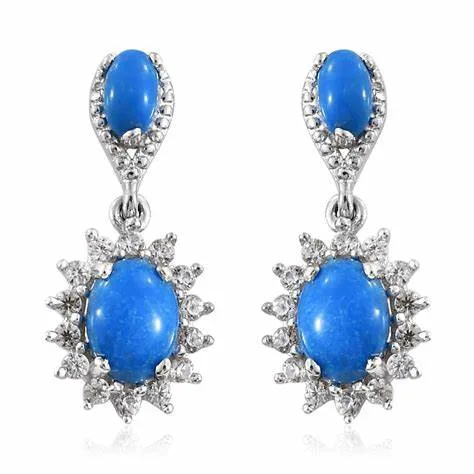
Ceruleite, with its captivating blue color and distinctive crystal habit, holds a special place in the field of gemology and jewelry, even though its use in jewelry is limited due to certain characteristics. Here’s how ceruleite is recognized in these contexts:
Aesthetic Appeal: Ceruleite’s vibrant blue color is one of its most appealing features. Gemologists and jewelry designers are drawn to this unique shade of blue, which can range from pale to deep azure. The color can evoke feelings of calmness and tranquility, making it an attractive choice for jewelry pieces that convey emotional or spiritual significance.
Collector’s Gem: While ceruleite is not commonly used in mainstream jewelry due to its relatively low hardness and fragile nature, it is highly prized by gem and mineral collectors. Exceptionally well-formed and vivid specimens are sought after by collectors for their rarity and aesthetic value.
Collector’s Jewelry and Art Pieces: Ceruleite, due to its delicate nature, may find its way into collector’s jewelry or art pieces that prioritize aesthetic appeal over practical wearability. Jewelry designers who specialize in unique and artistic creations might incorporate ceruleite into limited-edition or one-of-a-kind pieces.
Lapidary and Artistic Expression: Lapidarists and artisans might work with ceruleite to create custom-cut cabochons, carvings, or decorative pieces. While its low hardness may limit its use in high-wear jewelry, its use in artistic and statement pieces allows for creativity and expression.
Accents and Combinations: Ceruleite’s blue color can serve as an accent or complementary element in jewelry designs. It might be combined with other gemstones that share color similarities or provide contrast, enhancing the overall visual appeal of a piece.
Educational and Display Purposes: Jewelry incorporating ceruleite might be used for educational purposes, showcasing the unique characteristics of the mineral to the public. Such pieces could be part of museum exhibits or gemology-related events.
Symbolism and Personal Meaning: In alternative or spiritual practices, ceruleite’s color and perceived properties might hold personal or symbolic significance. It could be used in custom-made jewelry intended to convey specific emotions, intentions, or connections with natural elements.
Gemological Research and Classification: Ceruleite’s presence in the realm of gemology contributes to the comprehensive understanding of gemstones and minerals. Its study aids gemologists in recognizing unique characteristics and refining classification methods.
In summary, while ceruleite is not widely used in traditional jewelry due to its limitations in hardness and durability, its captivating blue color and aesthetic appeal make it a prized specimen among collectors and can find a place in artistic, limited-edition pieces. Its significance in the world of gemology lies in its contribution to the understanding of mineral diversity and its role in the exploration of creative design possibilities.
Notable localities where ceruleite is found
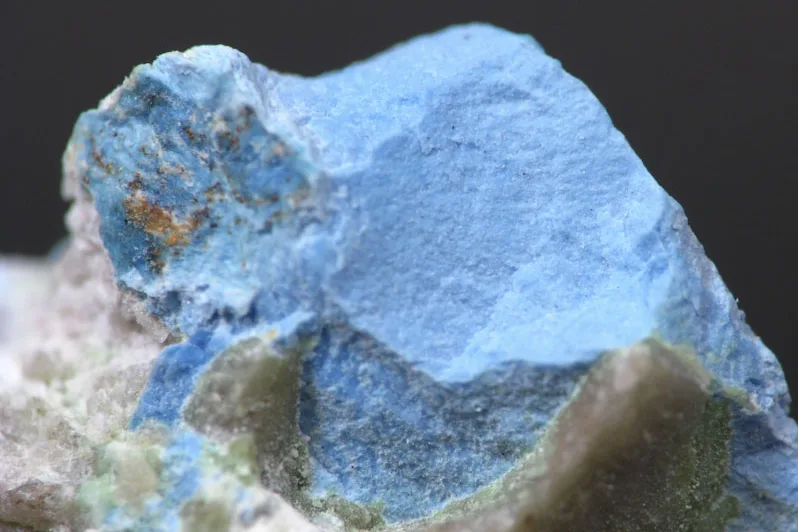
Ceruleite is a relatively rare mineral, and its occurrence is often associated with specific localities where copper deposits have undergone alteration and weathering processes. While it may not be as well-known as other minerals, there are a few notable places where ceruleite has been found:
- Bisbee, Arizona, USA: The Copper Queen Mine in Bisbee, Arizona, has been a significant source of ceruleite specimens. The oxidized zones of copper deposits in this area have produced fine examples of this mineral. Arizona, in general, is known for its copper mineral deposits and secondary mineral formations.
- Mashamba West Mine, Democratic Republic of Congo: This African country has yielded ceruleite specimens from the Mashamba West Mine. The mine is known for its copper mineralization, which provides an environment conducive to the formation of secondary copper minerals like ceruleite.
- Tsumeb Mine, Namibia: Tsumeb Mine is renowned for its diverse array of minerals, and ceruleite has been found there among other secondary copper minerals. The mine’s history of copper extraction and geological conditions contribute to the formation of such minerals.
- Lubietova, Slovakia: Ceruleite specimens have been discovered in the Lubietova area of Slovakia. Copper-rich ore deposits in this region have given rise to various secondary copper minerals, including ceruleite.
- Laurion, Greece: Ceruleite has been reported in the Laurion region of Greece, known historically for its mining activities. The Laurion district has been a source of various minerals, and ceruleite’s presence is part of the broader mineralogical diversity.
- Kabwe, Zambia: The Kabwe Mine in Zambia has produced ceruleite specimens among other secondary copper minerals. Zambia is a significant producer of copper, and its mining operations have led to the formation of various copper-bearing minerals.
It’s important to note that the availability of ceruleite specimens from these localities may vary over time due to factors such as mining activity, accessibility, and geological conditions. The mineral’s rarity contributes to its desirability among collectors and enthusiasts, and specimens from these notable localities are valued for their unique characteristics.


